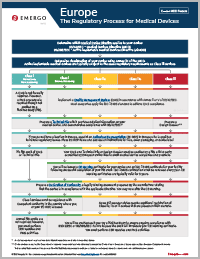Europe CE Marking Regulatory Process for Medical Devices

有任何问题?向我们的专家获取相关信息
联系我们In order to commercialize medical devices in the European Union, a CE Mark certificate is needed. This certification verifies that a device meets all regulatory requirements of the Medical Devices Directive (MDD), or Active Implantable Medical Device Directive (AIMD) as they apply to your product. For a more detailed look at the European regulatory process for medical devices, download the chart below.
Interested in CE Marking under the new EU Medical Device Regulation (MDR 2017/745)? Download our MDR process chart.
The European CE medical device approval process explained
The chart shown illustrates the CE approval process in Europe and is available for download in PDF format. However, if you would like to explain the steps to someone else in an email, you can cut and paste the text below or send them a link to this page.
Step 1
Determine which EU Medical Device Directive applies to your device: 93/42/EEC – Medical Devices Directive (MDD) or 90/385/EEC - Active Implantable Medical Devices Directive (AIMDD):
Step 2
Determine classification of your device using Annex IX of the Medical Devices Directive (MDD): Class I (non-sterile, non-measuring), Class I (sterile, measuring), Class IIa, Class IIb or Class III/AIMD. Active implantable medical devices are typically subject to the same regulatory requirements as Class III devices.
Step 3
For all devices except Class I (non-sterile, non-measuring), implement Quality Management System (QMS) in accordance with Annex II or V of the MDD.
Most companies apply the ISO 13485 standard to achieve QMS compliance.
For Class I (non-sterile, non-measuring), a QMS is not formally required. However a PMS procedure is required, though not audited by a Notified Body (NB).
Step 4
For Classes I through IIb, prepare a Technical File that provides detailed information on your medical device, and demonstrates compliance with 93/42/EEC. All devices require will require clinical data. Most of these data should refer to the subject device.
For Class III/AIMD devices, prepare a Design Dossier. Clinical studies are required for Class IIb and III implants, though existing clinical data may be acceptable. Clinical trials in Europe must be pre-approved by a European Competent Authority.
Step 5
If you do not have a location in Europe, appoint an Authorized Representative (EC Rep) located in Europe. The EC Rep should be qualified to handle regulatory issues. Place EC REP name and address on Instructions for Use, outer packaging, or device label.
Step 6
For all devices except Class I (non-sterile, non-measuring), your QMS and Technical File or Design Dossier must be audited by a Notified Body, a third party accredited by European authorities to audit medical device companies and products.
Step 7
For all devices except Class I (non-sterile, non-measuring), you will be issued a European CE Marking Certificate for your device and an ISO 13485 certificate for your facility following successful completion of your Notified Body audit. ISO 13485 certification must be renewed every year. CE Marking certificates are typically valid for 3 years.
Step 8
Prepare a Declaration of Conformity, a legally binding document prepared by the manufacturer stating that the device is in compliance with the applicable Directive. You may now affix the CE Marking.
Step 9
All Class I devices must be registered with the Competent Authority where you or your EC REP is based.
Some EU member states require additional registration of Class IIa, IIb, or III devices that are placed on their markets.
Step 10
For Class I (non-sterile, non-measuring), annual NB audits are not required. However, you must perform CER updates and PMS activities.
For all other classes, you will be audited each year by a Notified Body to ensure ongoing compliance with 93/42/EEC or 90/385/EEC. Failure to pass the audit will invalidate your CE Marking certificate. You must perform CER updates and PMS activities.
This is a simplified overview of the process. Your Notified Body may choose to audit your submission and request more documents, which will add time to your approval.
Chart updated: 05/22/2019
相关
-
欧盟医疗器械法规MDR 全新解读 – 共瞻2022医疗器械合规新要点
自新欧盟医疗器械法规MDR (Medical Device Regulation 2017/745) 申请日期起,欧盟医疗器械监管当局就发布了一系列新文件及相关支持服务,旨在帮助医疗器械制造商适应新法规变更后的法规环境。 对此,作为在全球范围内经验丰富的医疗器械及IVD器械市场合
阅读更多 -
视频回顾 | 2022中美医疗健康产业投资研讨会
2022年11月23-25日,2022年度医疗器械行业盛会CMEF(中国国际医疗器械博览会)在深圳落下帷幕。展会期间,美国驻广州总领事馆、美国驻上海总领事馆携手国药励展于11月25日成功举办线上“中美医疗健康产业投资研讨会”,共享2022美国前沿医疗健康产业发展趋势及最新法规合规资讯。
阅读更多